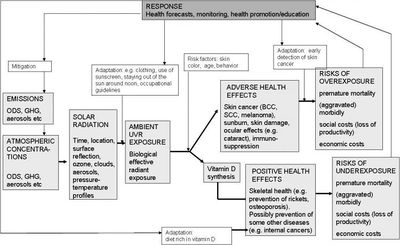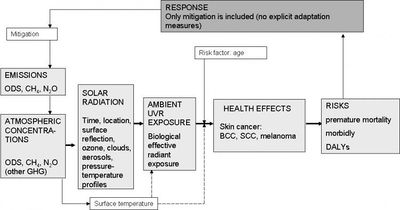UVR and future skin cancer
- The text on this page is taken from an equivalent page of the IEHIAS-project.
As part of the EU-funded INTARESE project, which contributed to the development of this Toolbox, a case study was conducted to assess health impacts associated with ultra-violet radiation (UVR) under conditions of climate change.
Issue Framing
The assessment explores the effects of changing exposure to ambient ultraviolet radiation (UVR) on melanoma skin cancer (CMM) and non-melanoma skincancer (BCC and SCC), accounting for future changes in stratospheric ozone (due to decreasing emission of Ozone Depletng Substances (ODS) and increasing emissions of CH4 and N2O). We also account for future demographic change.
Issue framing represents the first step in doing an integrated environmental health impact assessment.
In the case of environmental health, we are concerned primarily with the relationships between environment (as a source of exposure to hazards or access to resources) and human health. These relationships comprise a set of causes and effects – and typically involve many of each (i.e. many-to-many relationships). They are best represented, therefore, in the form of a causal chain or web (also known as the ‘full impact chain’), showing the links between sources and impacts, via a series of steps. This outline summarises the approach taken to developing a conceptual model of the UVR issue.
Explanation of the method
Figure 1 shows the assessment framework developed in the scoping phase. Scoping was based on a comprehensive literature review. Figure 2 shows how this broader picture was reduced to a more exclusive model for the purpose of assessment.
In the process from scoping diagram to final assessment framework, the following important inclusion/exclusion decisions were made:
- The changes in ambient UVR are only due to changes in ozone (under two different scenarios (SRES A2 and B1). Recovery of the ozone layer is influenced by two factors: 1) future changes in the emissions of ozone depleting substances (ODS) and 2) future atmospheric levels of relevant GHGs (CH4, N2O). All other optical properties of the surface and the atmosphere are assumed to remain unchanged (e.g. albedo, cloud cover, aerosols etc). However, changes in cloud cover are included in the sensitivity analyses.
- As an exposure indicator, we use the average erythemal dose instead of biologically effective dose, in order to match available DRFs.
- The UVR assessment primarily focuses on the negative effects on skin cancer, because the estimated global burden of disease and the attributable fraction are relative high compared to other health outcomes (Lucas, McMichael et al. 2006).
- The projected increase in summer surface temperatures due to climate change (under two different scenarios) is expected to affect the future health impacts as well, although the mechanism is not clear (via increased exposure behaviour or via increased ambient UV). This process is assessed through a sensitivity analyses.
- Changes in adaptation and exposure behaviour are not included.
- Future population growth and changes in population structure (ageing) will be taken into account (under two different scenarios).
- Skin pigmentation will not play an important role, as the population in the case studies is primarily lightly pigmented (Lucas, McMichael et al. 2006); DRF and PAF for lightly pigmented populations are assumed to apply to the whole population of our cases.
- The WP3.7-UVR assessment focuses on (attributable) incident cases, mortality and disease burden (in DALY). Due to lack of adequate data, no further cost estimates are performed.
References
- Lucas, R., T. McMichael, et al. (2006). Solar ultraviolet radiation: Global burden of disease from solar ultraviolet radiation. Geneva, World Health Organization.
See also
- Changing ambient UVR and future melanoma skin cancer
- Changing ambient UVR and future non-melanoma skin cancer


